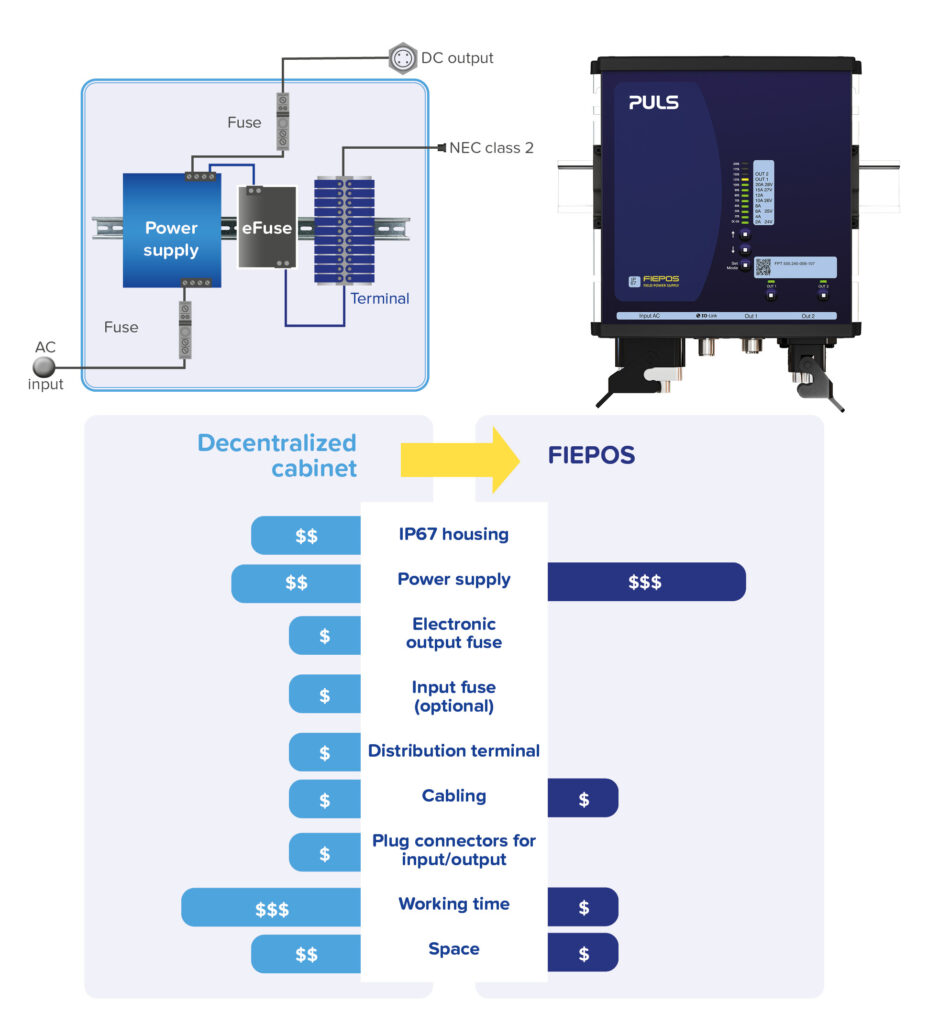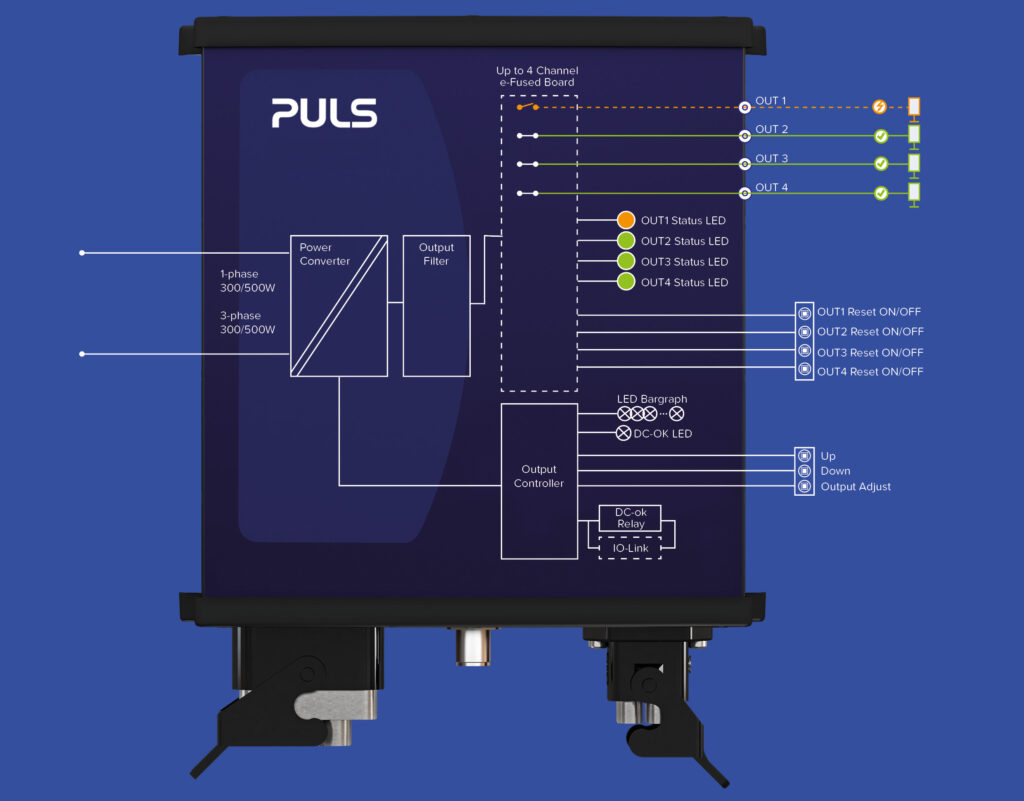By Kamil Buczek, Product Manager Rugged Products, Sebastian Lederer, New Product and Application Engineer, and Maximilian Hülsebusch, Marketing Communications Specialist, Puls
The demand for flexible, modular systems is shaping the world of automation, control and machine building. Decentralisation of system components has proven to be an important factor in this growing trend. It speeds up the system planning process, simplifies installation and maintenance, and facilitates future expansion. For many system builders and installers, the power supply has been an obstacle on the path to consistent decentralisation. In particular, where functions such as selective current distribution, protection and condition monitoring need to be implemented whilst providing maximum reliability and uptime.

Figure 1: Decentralised power supplies by Puls
Challenges and solutions
For achieving a decentralised power supply, an obvious solution is to design a system that can be mounted directly on a machine or installation. The power supply and other standard components such as electronic fuses, communication terminals, distributor blocks or switches are relocated from the central control cabinet to smaller enclosures directly in the field. The installation of these components outside of a fully environmentally-protected central cabinet means they will require a high IP rating individually to ensure protection against dust and moisture. Providing protection to class IP54, IP65 or IP67 may be required, depending on the application.
The result will be a small, decentralised on-site cabinet for which the individual components have to be selected, ordered, stored, assembled and installed, a time-consuming and complex task. In most cases there is very little space available on a machine to locate a control system, so finding a location for this cabinet can be problematic. Engineers often need to be creative, positioning the cabinets above or below the system making access sometimes difficult for installation and service technicians.
However, compact all-in-one solutions for decentralised applications are available, such as those form Puls. Its FIEPOS Field power supply family is based on a modular platform developed specifically for use outside of a cabinet. All models are based on either 1-phase or 3-phase input power with either a 300W or 500W output rating. All devices in the FIEPOS family provide 120% power continuously (up to +45°C) and 200% for 5s making them suitable loads with a demanding start-up cycle.
With a housing size of only 182 x 183 x 57mm (WxHxD), they can be installed even in applications where space is at a premium. The units can be mounted via DIN-rail or in place using a variety of mounting holes.
The FIEPOS product family (Figure 2) has two versions: The Basic series with one DC output which offers an optional integrated decoupling MOSFET for developing redundant power supply systems and the eFused series with up to four current-limited DC outputs. FEIPOS simplify the delivery of selective current distribution, protection and monitoring directly in the field, with no need for any further accessories, or costly, bulky enclosures. FIEPOS supplies are manufactured using a combination of modular boards futureproofing them by allowing new functions to be added by simply integrating alternative boards as required.

Figure 2: FIEPOS switch-mode
power supplies can be attached
directly to the machine and replace
complex, decentralized control
cabinets.
Selective current distribution and protection
The eFused range of FIEPOS power supplies offer an alternative to power sources that are protected either by means of an external electronic four-channel protection module, four external fuses or circuit breakers. To deliver selective current distribution, the eFused versions can integrate up to four electronic fuses allowing them to simultaneously supply electromechanical loads (e.g., motors) and sensitive loads such as controls or sensors from a single decentralised and fused power supply.
If there’s a short-circuit, the power supply selectively shuts down only the faulty output and reports this via the IO-Link or Output-OK signal and the LED interface on the front of the device. Due to active current limitation, all other outputs continue to be supplied with the proper voltage. This is particularly important in the case of sensitive and safety-critical loads such as PLCs or sensors.

Figure 3: FIEPOS eFused field power supplies are equipped with up
to four eFuses and a communication interface or functional signal.
Protected load branches
Requirements can vary greatly from one application to another. For this reason, Puls has developed various circuit designs for the most common applications, and there are several possible configurations:
- Two outputs – four load branches
This configuration allows up to four separate load branches with two outputs each. For this requirement Puls offers three eFused models with an output power of either 300W or 500W. With these models, two separate electric circuits per output can be achieved, allowing sensors and actuators to be independent of each other. If one sensor load branch fails due to a fault, the other three continue to be supplied with power; see Figure 4. The fault is indicated via IO-Link and the status LED on the front of the device. The communications and LED status allows maintenance to be performed quickly and efficiently. The tripped channel is reset using the pushbutton on the front of the device or alternatively, via IO-Link.

Figure 4: If one sensor load branch fails due to a fault, the other three continue to be supplied with power
2. Three outputs – three load branches
These options provide up to three separate and individually-protected load branches with one power supply for several sensors and actuators with power via each load branch; see Figure 5.
If a sensor connected to output 1 fails, the electric circuit is open. All sensors and actuators connected to the faulty output are no longer supplied with power. The fault is indicated via IO-Link and the status LED on the front of the device. Outputs 2 and 3 remain unaffected by this fault, and the power to these outputs is maintained.

Figure 5: There are up to three separate and individually-protected load branches with power via each load branch
3: Four outputs – four NEC Class 2 load branches
A power source with limited power may be necessary for applications installed in North America. For this reason, the maximum wattage of FIEPOS model FPT300.246-042-101 meets the NEC Class 2 requirements. Up to four load branches can be set directly on the front of the device or on the versions with integrated IO-Link interface, they can also be set remotely; see Figure 6.
In the case of an overload, the current is limited to ensure that the maximum power of 100W defined for NEC Class 2 is not exceeded. The other NEC Class 2 load branches remain unaffected by the fault on the first output.

Figure 6: Up to four load branches can be set directly on the front of the device or on the versions with integrated IO-Link interface
In the eFused series, the tripping current for each individual output can be set via the buttons on the front panel of the device. A different characteristic curve applies in each case, depending on the set tripping current. If the tripping current is set to 4A, the output allows 1.25 times the nominal current (5A) for a 2 second duration and then switches off.
The eFused power supplies have an integrated selectivity function which allows prioritised protection of sensitive loads. Output 1 of the four-channel eFused device FPT300.246-042-101 has the highest priority, output 4 the lowest. Therefore, a sensitive-, safety- or system-critical load such as a PLC, is best supplied via output 1. If the overall current is exceeded, the supply switches off the outputs with the lowest priority first.
Activation of the outputs is also staggered and are switched on in 100ms increments and according to their priority.
Condition monitoring
Digitalisation has led to a high priority being placed on a constant central condition-monitoring system. Seamless networking and communication between various system components allows comprehensive analysis of their status and early detection of anomalies in the system. In this manner, preventative and cost-effective maintenance can be carried out, reducing system downtime to a minimum. Additionally, this data can also be used to see the utilisation on the current application or a to make a strategic decision such as to expand the system. In both cases, the information provided by the power supply plays a key role. The power supply is at the heart of any system and allows conclusions to be drawn about its overall operational condition. FIEPOS eFused power supplies can be easily integrated into an existing condition monitoring system, providing status data in various ways.
In large-scale applications, there are often hundreds of power supplies distributed over a wide area. In these applications, efficient preventive maintenance via a central condition-monitoring system is particularly important in order to prevent costly downtimes. With the help of this information, a technician can quickly go to the correct location, possibly preventing a fault from occurring.
IO-Link
For implementation of the digital system integration of power supplies, Puls places great value on a user-friendly and flexible solution. However, the communication interface should not affect the core functions and high reliability of the power supply. Based on these criteria, Puls uses IO-Link technology (IEC 61131-9).
IO-Link is a global, standardised communication interface suitable for industrial use with serial bidirectional, point-to-point communication between an IO-Link device and the IO-Link Master. Simple, unshielded cables are all that is required for the wiring between an IO-Link device and the IO-Link Master. The IO-Link Master allows integration into any commonly used field bus or IIoT protocol such as PROFINET, EthernetIP, EtherCAT or OPC-UA. In this manner, the power supply can communicate directly with a PLC or an IIoT gateway via the IO-Link Master
A key advantage of the IO-Link interface is the low number of additional components required in the power supply. The MTBF (Mean Time Between Failures), a significant key figure for the evaluation of system reliability, remains virtually unchanged.
FIEPOS power supplies give users access to the following information via the IO-Link: How much output current, quality of the mains voltage, temperature and if the load on the supply is static or dynamic? This information allows users to detect abnormally high transient surges in the mains supply, which cannot only damage the power supply, but also adversely affect all other connected components. With the eFused models, it also detects via the IO-Link, which current-limited output has tripped and it is possible to reset the channels remotely.
All this information can be analysed in a central condition-monitoring system, allowing effective preventative maintenance and increasing the system reliability while cutting maintenance and operating costs.
Output-OK signalling contact
As an alternative to the IO-Link, the eFused power supplies in the FIEPOS product family are also available with an Output-OK interface. Its functions are similar to the established DC-ok signal of an industrial power supply. If the DC voltage fails, the device reports a fault via a common signalling contact in addition to the LED display on the front panel of the device.
However, the cause of the fault can only be diagnosed by a technician on site. The channels can also only be reset on the front panel of the device. An M12 connection is provided on the underside of the power supply for the Output-OK signal, as well as for the IO-Link.










